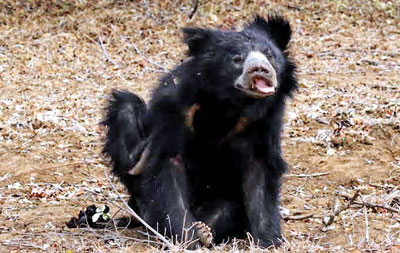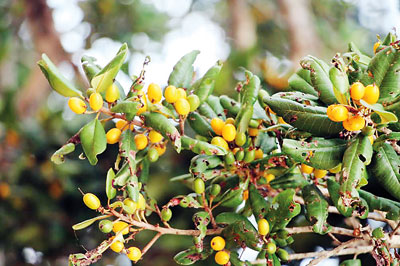Bear necessities, the palu fruits

Tipsy black bear under a palu tree. (Pix by Ajantha Palihawadana)
For the black bear, there is no greater feast than palu fruits straight from the tree. This gastronomic delight makes the nocturnal creature forego its night time pursuits and get intoxicated by palu even during the day! “They are oblivious to the world outside and can be spotted in various positions under the palu trees, some even in yoga position,” says Ajantha Palihawadana, Head of the Responsible Trail, the eco-tourism arm of the Yala Adventure Resort.
Although the flowering season of palu begins at this time of the year and the fruits ripen from June to August, as Palihawadana observes, in the Yala National Park, ripened palu had been spotted since the second week of May this year. “In Yala we noticed a very early flowering season of the fruit this year, as early as February where bees were collecting nectar from the palu flowers.” Perhaps a sign of climate change as Palihawadana reflects, early fruiting means an unexpected lottery for the nocturnal black bear. “The Palu season is the best time to photograph the creature and at times they are seen nestled among the palu branches for hours and if the drought is prolonged, they eat the fallen berries under the trees which are fermented and become drowsy,” says Palihawadana who has captured the ‘tipsy’ bear and its footprints under the palu trees of Yala. The berry is also a staple for other fruit-eating creatures such as the giant squirrel, civet cat and the Gray langur, says the nature lover and researcher.
Botanically termed Manilkara hexandra in the Sapotaceae family, palu or Ceylon Iron Wood is found in abundance in the dry arid zones and along the sandy coast of the country. “Palu is one of the most important components of the vegetation of the ‘dry ever green forests’ in the country, notably in the North, East and the North Central. Yala, Bundala, Wilpattu, Kumana, Udawalawe, and Wasgamuwa National Parks are also well known for the tree . The tree is also prominent along the Southern coast,” explains Prof. Siril Wijesundara, Research Professor, National Institute of Fundamental Studies and former Director General of the Department of National Botanic Gardens. A chief factor of the ‘high canopy’ of these ‘dry ever green forests’, palu trees grow up to about 25-30 metres in height, he says.
Sought after by birds and wild beasts, palu when eaten in excess, could have an intoxicating effect on the two legged and the four. “Growing in the South, palu was part of our lives and I still recall being unable to open our eyes the next day, having been palu gluttons as the berry is believed to be containing ‘heaty’ properties when consumed in excess,” recollects Prof. Wijesundara.
The berry, found largely in the tropical Asian regions and predominantly in the Indian subcontinent, palu is a subject of serious horticultural research in India according to the Botanist. “We too should take a cue from the Indian experience,” maintains the scholar who notes that ripe berries are dried in open air and the dried fruit commercially promoted in India.
Claiming a ‘characteristic bark’ as Prof. Wijesundara illustrates, the palu tree is also renowned for its adaptations to mitigate water loss. “Palu bark is what is botanically termed a ‘fissured bark’, denoting a dark, thick texture. The leaves of the tree are thick and the edges are curved inwardly with a shiny surface and help prevent water evaporation.” The tree can also withstand coastal climatic hardships, says the Botanist. Rich in vitamins, palu is also renowned for its medicinal properties. “Similar to moona mal, which is used in oral care, especially for gum disease, palu too is a sought after herb, since both these plants share the same genus,” says Prof. Wijesundara. Palu is also a proven herbal remedy for dysentery.
The sudden decline of Palu in the South of the country is a matter of concern over which studies are underway, says Prof. Wijesundara. The research by Prof. Anoma Perera of the Botany Department of the Peradeniya University is still unravelling the exact causes for this sudden loss. “A multitude of factors comes into play. One of the key assumptions is the changes in the water table in the region with irrigation projects such as the Lunugamwehera Augmentation Programme impacting on the salinity levels of water,” explains Prof. Wijesundara.

Ajantha Palihawadana

Prof. Siril Wijesundara


